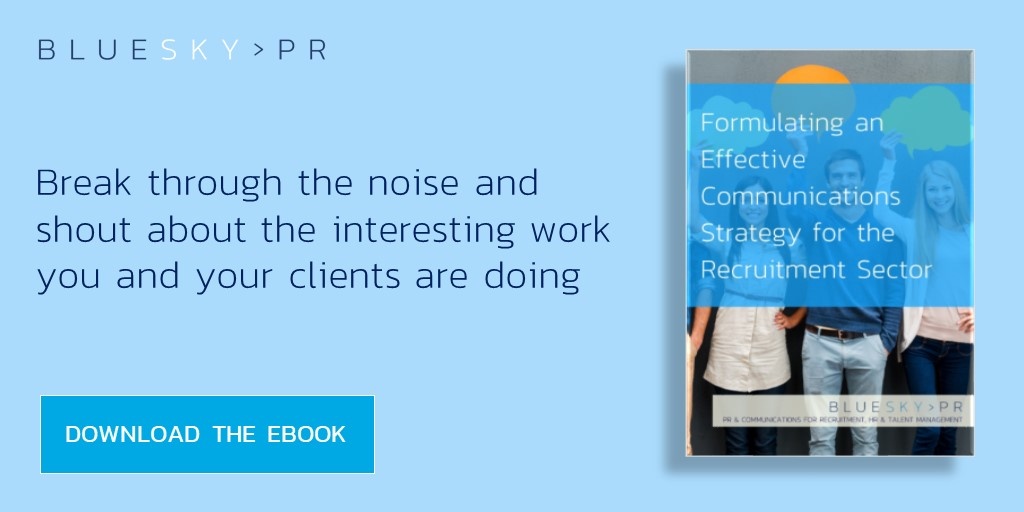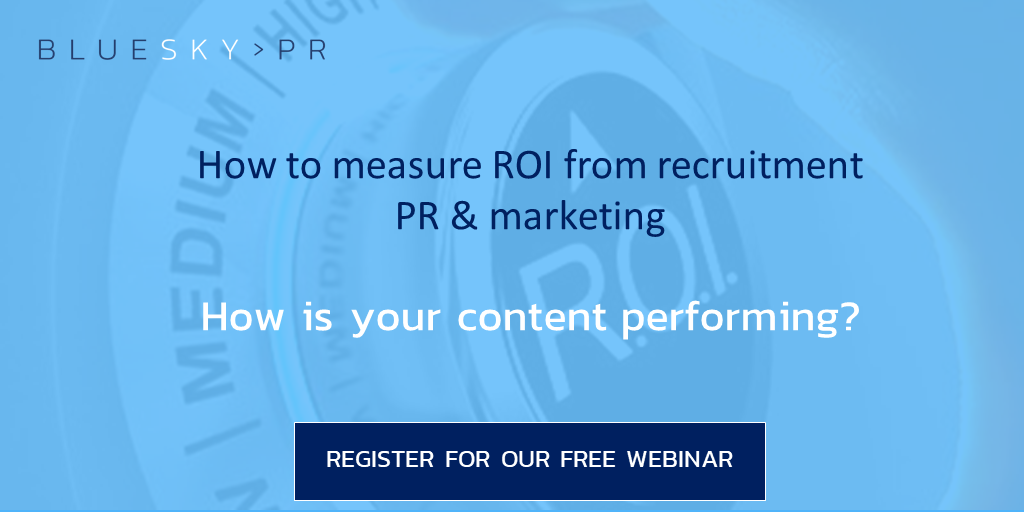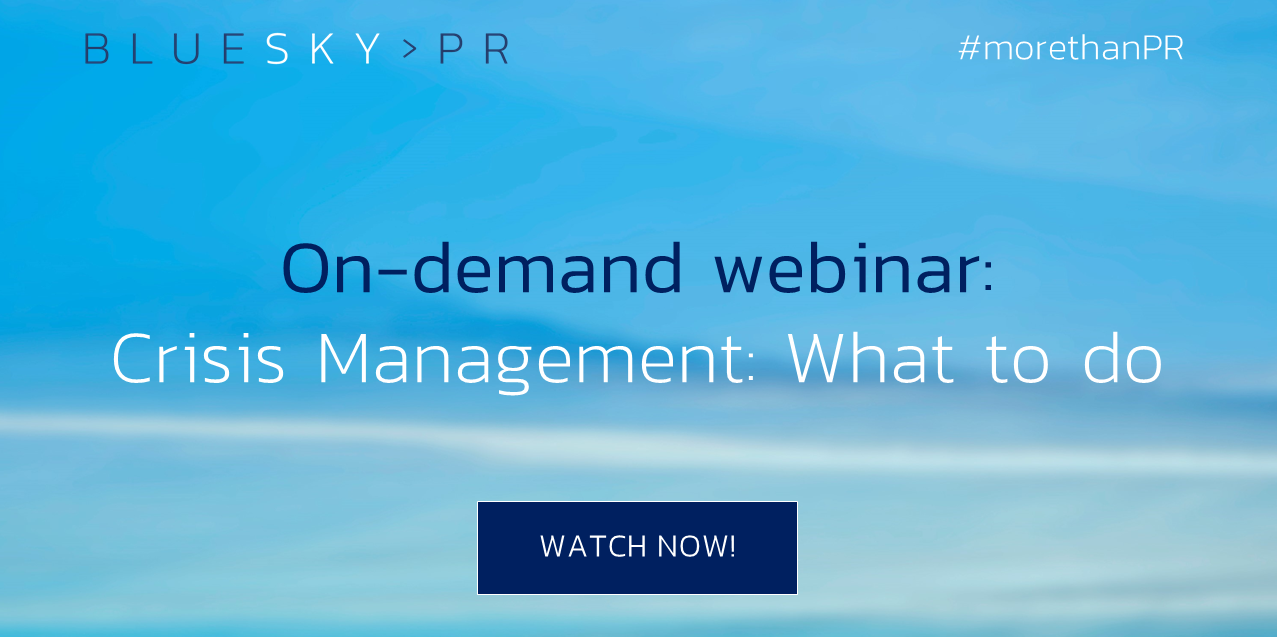PR for Recruiters

Contents
- What is PR and how can it help recruiters?
- PR for recruiters: an ex-consultants view
- Myth busting: top PR misconceptions
- How to create a PR plan
- Top tips for creating content
- How to write a press release
- 9 overlooked ingredients of a successful blog post
- Crisis 101: top tips for dealing with a PR emergency
- PR lessons from the apprentice
- PR for recruiters: measuring PR effectively
- PR: outsourced or in-house?
- How to choose a PR agency?
- Case studies: the 100k article
What is PR and how can it help recruiters?
Public Relations, or 'PR', is all about the way organisations communicate with the public, promote themselves, and build a positive reputation and public image. PR professionals help a business or individual cultivate a positive reputation with the public through various unpaid or earned communications, including traditional media, social media, and in-person engagements. They also help clients defend their reputation during a crisis that threatens their credibility.
Unlike advertising, PR is “earned media” and not paid for. Having your presence out there without the help of paid-for-marketing is increasingly important amongst the public as according to research carried out by Ipsos Mori, seven in ten Brits claim to trust advertising less than they used to.
Who is PR for?
While just about any company can invest in PR support, organisations that are willing to share their views on an ongoing basis will reap the most benefits from public relations. Those ready to bolster their current business plan with strategies for further growth will certainly be pleased with the results that come from hiring PR.
Furthermore, companies that are sitting on a wealth of data and knowledge – which applies to many recruitment firms – can certainly see results from PR, and enjoy all benefits that being a strong thought leader in their field brings.
So, how can good PR help recruiters?
Winning clients and candidates
A good PR strategy can help to attract the very best talent and most prestigious clients. Let’s face it, it’s much easier to recruit and attract candidates to a company they have already heard of. However, in the ongoing war for talent, now more than ever companies need to look at putting their best foot forward, and a competitive PR strategy can do just that.
Ensuring potential hires not only know ‘of’ you but also have a positive impression of your brand is key. This is where PR comes in – playing a crucial role in ensuring that firm’s opinions, thoughts, success and growth are highlighted. This will undoubtedly gain the interest of potential staff wanting to find out more.
Media coverage offers you third party credibility that you can’t really replicate anywhere else. When you’re in publications read by your target audience, it makes your direct approaches less cold. When you are being seen regularly as a thought leader, you’ll be the first agency a potential client thinks of when they’re hiring, or the agency that candidates call when they’re considering opportunities.
Managing your narrative
Companies that fail to invest in PR are essentially giving up control of their narrative. However, those that do are ensuring that their story will be constantly reviewed and refreshed in line with their wider goals.
This will help to not only attract customers and prospects, but also continually challenge an organisation to think about the messages it is sending out and whether or not they are relevant or effective. In the lighting-paced digital media landscape that we currently occupy, failing to take control of this will see your company left behind by competitors.
Getting the most out of your expertise
Recruitment companies are experts in their given sector, and usually have access to a wealth of data that is relevant to candidates and clients. By taking advantage of this expertise and using this information to produce quality content – recruiters can truly get the most out of this expertise.
PR can also help you spread this information as far as possible and across as many mediums as possible. For instance, a blog can be converted into a press release, which can also be transformed into a full-length press feature
However, don’t just take it from us – here are the thoughts of our Head of Client Engagement and ex-recruitment consultant, Izzy Carnell:
PR for recruiters: an ex-consultants view
“I have in-depth experience recruiting within the PR and communications sector for various clients across different markets. So, I can confidently say that PR is a perfect way for recruiters to reach their full potential in an ever-growing market.”
Here are 3 of the main ways I believe PR could’ve helped in my time as a recruiter:
Attracting clients and candidates
PR separates recruitment businesses from their competitors and introduces new ways to attract potential clients and candidates. As a recruiter you are constantly looking for the next best client or top-class candidate and, in an increasingly competitive market, PR paves the way to a stronger business development and growth strategy. We’d love new business and candidates to come to us from our credibility and expertise and this is exactly how PR can help.
A simple press release can be used in so many different ways across various social media channels to draw in your target audience, especially when shared by consultants – who tend to have 10x larger networks than their companies, and are 3x more likely to be seen as authentic when sharing information.
Driving engagement
Engagement is the key to successful business development, and PR drives engagement in so many ways.
Using current news and relating this back to your business can help spark engagement, showcasing yourself as a thought leader and allowing you to make connections that could have previously proved difficult.
Getting your name out there in relevant recruitment press will increase credibility and demonstrate your expertise.
Finally, kneeing able to create valuable content and stretching it across numerous different platforms draws people in and creates an effective way for clients and candidates to interact with your brand.
Advancing business development
PR creates credible material for recruitment agencies to evolve their business development. Furthermore, when it comes to PR for recruiters, many already have the resources at their fingertips. Recruitment CRM systems provide tons of data that can be used to create thought-provoking pieces to trigger engagement.
This data can be presented in different ways to target multiple streams of potential new clients and candidates. Using this data and recording the engagement it drives e.g. shares, likes, traffic and Google Analytics can help you to measure the positive effect that PR has on the recruitment BD cycle.
Now you know what PR is and what it can do for recruiters - Here are some things that it isn’t!
Myth busting: top PR misconceptions
It’s all about the press release
A quick search reveals that a worrying number of people think PR stands for press release, but it’s so much more than that. Yes, a release is an effective way of getting your name out there, but what if you want to establish yourself as a thought leader in your industry? There are myriad options for firms to utilise when diving into the world of PR, the press release is just one of many including white papers, articles, surveys, polls, events and more.

PRs spend all day drinking
It’s not Ab Fab, well not anymore. In the past, PRs could form bonds with journalists essentially by buying them a few drinks, but that’s no longer the case. The world has changed – the media in particular has shifted dramatically – and now, frankly, there’s not enough time to spend a few hours in the pub selling your client to the relevant individual. In the era of ‘productivity’ that we live in, it’s considerably more challenging to convince a journalist to take time out of their pressurised and time-short day which they could spend actually doing their job.
It’s easy getting publicity
It’s not – journalists get hundreds of emails and calls per day – and even particularly engaging stories may not be picked up if they’re packaged and presented in the wrong way. Putting a subject line in an email to a journalist that reads ‘Thrilling new cutting edge announcement about game-changing super product,’ will only get instantly deleted. The industry is much more nuanced than in the past and getting publicity is all about the strength of your contacts and the quality of your material. Without both of those things, you’re unlikely to get featured.
All press is good press
This is one of the most popular myths about PR. Ask SeaWorld whether it believes ‘Blackfish’ was good press, or how Ratner’s fared after its owner described its products as ‘total crap’. The answers will be overwhelmingly negative. SeaWorld has recorded plummeting revenues (84% in 2015 alone) since the damaging documentary was released and has seen visitor numbers cut in half.
PR can’t be measured and is therefore pointless
In the past, it may have been hard to measure ROI, but in today’s world with numerous analytical tools at our disposal, this isn’t an issue. If you’re looking to drive increased traffic to your website, for example, Google Analytics can identify how and when people accessed your site and their journey through the different pages, which allows you to measure the demand for your content.
Ultimately, it depends on your goals and what platforms and methods you should adopt depends largely on what you want to achieve. If you want to bolster your social media channels then an increase in followers and engagement is a clear indicator that you’re getting ROI. This is just one of dozens of examples and the reality is, there’s no excuse for not measuring the success of your PR activity.
Now you know what PR is and isn’t, let’s have a look at how to create a PR plan:
How to create a PR plan
Step 1: Outline your goals
When you create a PR plan, the first step must be to outline what it is you want to achieve. These goals can be as few or as many as you need. What’s important is that you make them clear, achievable and consistent with the overall objectives of your business. Time frames are also important – plan out a set amount of activity for a certain period, and a date for revising plans later on. For instance, you could start by considering the full year ahead, planning for six months, and revising after three. Like everything in business, PR requires flexibility and a recognition that things may change over time.
Step 2: Who is your target audience?
Identifying your target audience is another invaluable step. All the best PR work in the world will mean nothing if the audience isn’t relevant and receptive to your message. Whose support do you need to reach your goals? Who will be interested in what you have to say? Once you’ve identified this, research where you can find and influence your target audience. For instance, start looking at the relevant publications in your sector. Or perhaps targeting social media and bloggers would create more engagement. Defining this is absolutely essential. Without it, you are going in blind
Step 3: What are your key messages?
Defining your key messages is a crucial first step, and one of the core components of a good PR strategy. These are the messages you want to portray to your audience. They will shape your content and enable the completion of your goals. When you create a PR plan, this is a stage you cannot skip, and something that should require serious thought. To figure out what your key messages should be, think about your overall goals, and what content would help achieve this. The best key messages are believable, easy to understand, relevant, and succinct.
Tactics
Now you’ve worked out your messages and target audience, you need to consider the best tactics to reach them. Here are some of the most common examples:
Press releases – Plan out the press releases you intend to issue throughout the year or month, and be on the lookout for topics that you could react to, or ‘piggyback.’
List-building and pitching – Take the time to research and build a database of relevant reporters or bloggers that you can then pitch in ideas to – remember – this will change regularly and will require constant upkeep.
Editorial calendars – Look at forward features of magazines and websites, as they can offer an excellent way for gaining exposure, and planning out future activity.
Contributing bylined articles – This is will help you not only generate exposure, but also establish yourself or your business as a thought leader in a sector.
Case studies – These work similarly to bylined articles, but also offer a tangible, real-world example of the benefits of your product or services. However they can be more challenging to develop as they require active customer participation.
Speaking opportunities – Research conferences, trade-shows, webinars and roundtables for opportunities to put forward your client or business as a speaker or a member of a panel discussion.
Blogs and social media – Research the blogs relevant to you, get to know the styles and personalities of their authors, and the type of content they’re putting out.
Measurement
Measurement is a key part of a campaign that is often overlooked. Why bother putting considerable time and money into PR without an accurate way of measuring the value you’re creating? While measurement may be a chore to some, without it, you won’t learn anything. Sadly, so many companies neglect this, with 50-60% of PR campaigns having no method of evaluation at all. Measurement should be considered from the very start when you create a PR plan. Accurate KPI’s should then be created in order to track success. Share of Voice, AVE, quality and quantity of coverage, leads produced and plenty of other methods can be used to measure how effective your efforts are. What’s crucial is that you outline how you intend do this the start of a campaign and stick to the same metrics consistently.
However, the best laid plans won’t come together unless you know how to deliver great content. Before we go in to the specifics– here are 5 tips that can apply to any form of content.
Top tips for creating content
Most firms understand the importance of having original content such as blogs, company news and professional insights on their websites. Firstly, if visitors to your site discover something useful or interesting, they are more likely to return. Secondly, it allows your firm to position itself as an authority and provider of relevant, engaging information. Finally, quality content gives you more material to share on social media, consequently creating wider exposure. This is also important as research shows that social shares influence where your website appears in search rankings. So, here are our top five tips for creating material with impact.
Establish the audience and purpose
Have a clear idea about who you are writing for before you begin. If it is for clients or candidates, what are their pain points and how will the piece address that? Then consider why you are writing it for them. For example, is it to inform them about an emerging issue, explain a complex matter or advise them on an aspect of their career? What will they learn that they didn’t know before?
Enlist the help of others
A good range of content often has input from more than one person. Involve your consultants as they will sit on lots of information and might have some great ideas about the issues which are affecting clients the most or other interesting topics which you could write about. You could even interview them about their roles and experiences. Also, ask others to comment on and proof read your pieces before uploading them: fresh eyes are always useful.

Make it punchy
A typical blog post is around 500 words. Remember that less is more- don’t waffle. Plan what you will say before writing it: one way is to bullet point the main things that you want to get across. Divide ideas into paragraphs and use subheadings to make the focus of each one clear. This also helps readers skim ahead to the parts of your piece that are most relevant to them. Ensure that the title summarises the content so readers can see at glance what the article will be about.
Keep it current and regular
There’s a tendency for many agencies to start producing content with real enthusiasm and then, over time, let the number of posts dwindle. Sometimes, there isn’t a post for many months. Ensure that yours are regular and avoid leaving long periods of time between them. Also, don’t upload a number of items at once: drip feed them at regular intervals. This creates the impression of a well-maintained page of content. It also means that the pieces are more likely to reflect timely news and issues that hold relevance for the page’s visitors. And, with the latter in mind, keep your finger on the pulse of current affairs in your sector and use this to help you create the most engaging content.
Push out the content
Once content is uploaded, you want to push it out to a wider audience. Use your social media channels to share the pieces and ensure that consultants are also playing a part in this. You can increase traffic to other posts by including links to them at the bottom of the feature, to encourage readers to carry on looking at your other articles.
Now, let’s look how to produce some of the specific forms of content that will bring your PR plan to life – starting with one the most common tools in the PR professional’s arsenal, the press release:
How to write a press release
A press release is the most basic and important tool for communicating with the media. Why? Simply because journalists and editors have become used to them and know how to deal with them or, in the majority of cases, how to delete them from their inbox.
A good press release encapsulates a story to gain media attention – a bit like a good mailshot in the recruitment sector. As with a mailshot it needs to be targeted, be relevant and communicate quickly and clearly. Here’s an example of one we did for a client which ended up getting both domestic and international coverage over the course of a whole year:
Workplace diversity a “glorified PR stunt” according to UK accountants

Despite the proliferation of formal initiatives and policies to promote diversity in the workplace, only a minority of Britain’s accountants are convinced that they are anything more than what one described as a “glorified PR stunt.”
According to a survey carried out for the financial recruitment specialist, xxx, only 35% of those questioned thought that formal diversity programmes were having a real effect on the companies they worked for.
“We’ve got a programme, which is supposed to ensure that we’re recruiting people from all different types of backgrounds and ethnic groups,” says one ACA, working for a major investment bank, “yet practically everyone at senior level is still white, middle class and male. Where’s the diversity in that?”
A female part-qualified CIMA in another bank had a similar jaundiced view. “There’s supposed to be a level playing field here, but the only women who really get on are those who are willing to forego a family and commit completely to the bank,” she says. “There are a few at senior level with children but if they ever get to see them it must be a minor miracle.”
When asked why employers set up diversity programmes, 54% believed that it was to generate good PR and 73% thought that it was because they feared prosecution under discrimination laws. Only 29% believed that companies had a genuine commitment to creating a diverse workforce at all levels.
However, despite their apparent cynicism about progress towards it, the majority (85%) of the 170 accountants questioned thought it was a highly desirable aim.
“There’s obviously a degree of cynicism about how committed large companies are to diversity because power in these institutions often still resides in the hands of a markedly un-diverse group,” says xxx.
“However anyone who thinks that they are not committed to changing this in the medium to long-term is kidding themselves. Organisations of this size and scope aren’t doing this for any fluffy, altruistic reasons. They know that there is a compelling business case for mirroring an increasingly varied customer-base. And they also know that if they want to recruit and retain the best people in the market they need to be fishing from the widest possible pool of talent.”
OK, so why did this release work so well?
- It’s about a subject that is already widely discussed in the press so we already knew there was an appetite for this sort of material and that it was likely to keep up for some time if not indefinitely.
- It’s controversial – it doesn’t just tell you want you know already.
- It’s based on the views of a group rather than just one person or organisation so has extra ‘credibility’.
- Its headline grabs immediate attention.
- Each paragraph has something to say – always work on the basis that if a sentence or paragraph doesn’t tell you something or develop the story then strike it out.
- It has ‘human interest’ – you can read quotes from the real people behind the research telling you what they think.
- It’s short and to the point, but contains enough material for a journalist to build an article around it.
Now let’s look at blogging, and some of the key aspects of a great blog post that often forgotten about:
9 overlooked ingredients of a successful blog post

1. Making a point
This might seem obvious, but many blog articles have nothing to say. Well, they might have something to say, but they don’t have a point. When your blog has a solid hook, it gives readers a reference point to latch onto, making them more likely to share, comment, and engage.
2. Give away knowledge
Many bloggers and companies alike hold back their best knowledge in fear of giving away their ‘secrets’ for free. However, with the wealth of information available on the internet, your ‘secrets’ are probably not as valuable as you think, and this information will end up being put out elsewhere – by someone else. By giving out as much value as you can in your blogs, you’ll become more attractive to visitors.
3. Subheadings
Subheadings help blogs visually. They guide readers through pieces and prevent them being rigid walls of text. When divided into separate points and paragraphs, readers can easily navigate blogs to find sections of interest. Subheadings are also great for SEO. Google uses them to help it understand content, and whether it’s relevant enough to appear on searches.
4. A call to action
The call to action is a crucial ingredient in a blog post. Whether it’s creating an account, visiting another page or purchasing a product, you need a call to action for every post. Possible several depending on the length.
5. Internal linking
Internal linking - where you link to related posts within your own site, can enhance your blog and website. Firstly, you’ll need enough content to link to. There’s no point sending readers to the same few pages over and over. Then, start creating links. Try to direct audiences to ‘deep pages.’ The deeper the page is within your site, the better. This means don’t send them to your home page, or other major pages on your website. Finally, ensure where you’re guiding audiences is relevant for engagement and SEO purposes.
6. Optimise your alt text
Blogs with images need optimised ‘alt text’ which tells search engines what images are about, helping a post rank higher. Adding relevant keywords to your alt text may seem like an insignificant thing - but it’s worth the extra effort to change something like "IMG735450" into something accurate and descriptive in the hopes it pushes your content up the rankings.
7. Optimise the Meta description
A Meta description is the small bit of text that appears underneath your link on Google. It gives people information to determine whether your content is what they're looking for. Using this space wisely is key, as in the split-second decisions that people make when choosing which link to click, this could be the factor that sends them to yours.
8. Write timeless, or ‘evergreen’ content
Finally, try to put out lots of evergreen content. These are posts that stay relevant—similar to how evergreens retain leaves all year around. While much of your blog may revolve around topical material, always writing material based on current events means that it’ll get dated pretty quickly. By writing more general, wide-ranging content that will be relevant regardless of circumstance, you’re more likely to pull in visitors.
9. Think longform
With Google algorithms changing so frequently, it’s not only vital that you blog on a regular basis on topics that are useful for your target audiences, but they also need to be the correct length to rank on the search engine. Google no longer simply looks ate many times a key word is used, but it also looks at other more relevant factors such as semantically linked keywords, a site’s authority, the amount of time users’ spend on the site and the length.
However, while these tips may help you put out content in a normal situations – what should you do if things really hit the fan?
Crisis 101: top tips for dealing with a PR emergency
Act immediately
As soon as you are aware that you have a problem, start the process of dealing with it, rather than trying to hide it yourself. Involve the people that need to know as soon as possible so that nobody is first made aware of the matter by a reporter. Your communication professionals should be part of those in the loop.
Get experts
Get those with expertise - usually your PR team - to handle internal and external communications. They will know how to word things in a way which doesn’t fuel the fire.
Issue a simple holding statement
This will reassure your stakeholders that you are aware of the situation and are assessing it. This will give you time to investigate further and prepare a more detailed statement.
Decide your point of contact
Decide who will be your point of contact for all related telephone calls and other communication and instruct staff to direct enquiries to them. This will stop unprepared employees from being put on the spot. Instruct all personnel not to give off-the cuff interviews or speak to anyone from the media without prior agreement. Ensure that only approved comment is released to the media. Those who do speak to the media need to be fully briefed on what to say and what to steer clear of.
Take responsibility when you need to
Hold your hands up and apologise rather than make excuses and, if you need to make a change to the way that you operate, make it clear how you plan to do so.
Monitor social media closely
It is much harder to manage than the press and broadcast media because all kinds of people can pile on with little regard for the facts. Make sure you know what is circulating so that you can respond when necessary with approved key messages. Similarly, ensure your search engine history doesn’t throw up comments which are at odds with your current position.
However, if you want to avoid your own crisis – why not take a look at some of our PR lessons to avoid from the Apprentice. Here’s some takeaway tips from the recent series from our very own Head of Practice, Vickie Collinge:
PR lessons from the apprentice
1. Why you should never over promise (or outright lie)
Recruitment marketers – It isn’t worth over-promising just to keep your MD off your back. If you know their expectations for PR and marketing are unachievable, tell them. The alternative is having to explain why you’ve not delivered what you promised.
And for recruitment directors and company spokespeople. Don’t exaggerate the truth. Just as Lord Sugar was brutal in pointing out to the men that they made a fundamental error saying they can ‘guarantee’ tourists will see the Big 5 on their safari, it will backfire if you make a statement that isn’t 100 per cent correct. So check all of your facts before saying or writing anything publicly.

2. Why you need to listen to your audience
Be very clear who your audience is, what type of content appeals to them and where to best engage with them. Expert recruiters know their candidates and client markets inside out, BUT, that doesn’t mean that what they know today, won’t change tomorrow, so never assume you or your team knows best.
What are people saying in response to your social media posts? Are there comments that suggest you should be rethinking some of your candidate engagement strategies?
And if there are any negative comments, consider how you should react to these. Yes, there are the odd occasions were someone is simply trying to entice you into a public argument for the sake of it, but in amongst this there may be real concerns or queries that should be listened to and addressed.
Communication is a two-way street and needs to be treated as such. It’s easy to fall into the trap of believing you know best, but if your audiences are telling you something different, you need to acknowledge it.
Similarly, if an expert is suggesting that your audience doesn’t want to hear about the new colour you’ve painted your office, but will be interested in the hiring trends in your industry, it’s worth taking note.
3. Why you need to have a voice
Staying quiet and reserved won’t help your brand get noticed. I’m not saying all publicity is good publicity. Or that you need to ensure your name is in every national paper, sector magazine, online blog or specialist podcast. Spreading your brand too thin won’t help you secure your position as a thought leader. Instead, the right content targeted at the right places will ensure you set yourself up for the best competitive success.
We often speak with recruitment agencies that want to remain quiet in fear of ‘giving away’ too much information to competitors. But the truth is, if another agency is operating in the same field as you, it’s very likely that they will know much of what you have to share anyway.
Success for us is when a client becomes the go-to business for crucial sector specific information. That doesn’t involve spilling the beans on your investment plans or the business you’re courting at the moment (though name dropping high-profile brands you have a great relationship with always helps raise your profile).
4. Why you should keep it real
Being authentic in the public eye really works and it’s arguably a million times easier to maintain than a false persona. Focusing on your area of expertise, rather than trying to be the expert voice on absolutely everything, will deliver the right results. It doesn’t really matter what your thoughts are on starting your own business if your target audience are employers and contractors in the life sciences field, for example.
For recruitment firms this is a key lesson for any PR activity: don’t stray too far from your comfort zone. Trying to be an expert in everything will dampen your reputation in the field you know best. Just as trying to do too much in one go can confuse your message and potentially limit the impact of your campaigns.
Sometimes simplicity really is best. And by honing your attention on one specific theme or audience at a time, you really can ensure you’re giving this activity the time and investment needed to ensure you note the best possible return on investment (ROI).
5. Why everyone needs to be on the same page
No one can be an expert in everything. So, many recruitment firms will have more than one spokesperson – particularly larger businesses with multiple specialisms. This is a necessity to grow the image of these individuals as experts in their specific fields. BUT this can open you up to inconsistencies. If, for example, you have two outspoken people who have opposite views on the value of technology in recruitment, having two contradictory messages going out to your audience isn’t ideal. So make sure any crucial messages are agreed between all parties to avoid these types of confrontations.
While learning how to effectively gain media coverage will undoubtedly help agencies and consultants, how can recruiters measure these PR efforts to make sure they work?
PR for recruiters: measuring PR effectively
While PR measurement may be a chore to some, it is an integral part of communications and something that pays dividends in the long run. However, so many companies are neglecting it, with 50-60% of PR campaigns having no method of evaluation at all. Here’s how to measure PR effectively:
Goal-setting
Ultimately, the return on your investment depends on the desired goals of a campaign, so goal-setting is fundamental. These targets should be as quantitative as possible and address who, what, when and how much the program is intended to affect. This could mean an increase in client acquisition in your sector or higher numbers of candidate registration. Goals should all be agreed on upfront, along with the metrics for measuring them.
Business results
One important way to evaluate PR effectively is to track how activities are affecting business KPIs. For example, monitoring your company’s website traffic during a campaign to ascertain whether there has been an increase in visitors or not.
A well-executed PR campaign will usually directly contribute to sales leads, so to find out whether your PR is working, it’s important to track where each lead comes from. For example, you could survey new customers to find out how they heard about the company.
Quality as well as quantity
When measuring coverage, quality matters. Is your coverage in a publication that potential clients and candidates read and engage with? Is your company being portrayed in a positive light? What is their share of voice (SOV) throughout the piece? Is it a reputable publication? All these things affect the overall quality of the coverage. Simply accumulating a large amount of irrelevant coverage is not effective and this should be reflected in your measurements.
AVE is not the be-all and end-all
Advertising Value Equivalent (AVE) is a commonly used metric to measure PR effectively and can be useful as a catch-all method for doing so. AVE is the estimated cost of buying the space taken up by a particular article, had the article been an advertisement. While it can often make PRs look like they are providing huge amounts of value, it isn’t always ideal for capturing the true worth of a campaign. Consumers don’t view a news article and advertisements with the same weight, and there many other considerations to take into hand. While AVE figures provide an easy way to show how much value you are creating, it takes no account of the tone of coverage, and cannot reliably quantify the value of social media at all.
Measuring social media
Social media measurement is an absolute necessity. But much like measuring traditional media sources, quality is more important than quantity. While measuring metrics such as likes, followers, and engagement can be simple and effective, don’t rely on these ‘vanity metrics’.

Make sure you are analysing the relevancy and quality of these likes and follows to your overall goals. For instance, are these coming from potential clients or important individuals from target sectors? Are potential candidates engaging with your content? If anything, large amounts of engagement from irrelevant sources should reflect negatively on any measurements.
When it comes to social channels, organisations will need clearly defined goals and outcomes for social media. This should be supplemented by web and search analytics, sales, and CRM data, survey data and other methods.
No ‘holy grail’
Ultimately, there is no ‘holy grail’ when it comes to PR measurement. The best way to do it is to have a detailed, well-thought-out action plan, and use the best tools available to you to constantly evaluate whether your PR efforts are aligning with those goals. A good PR campaign will very clearly meet these goals and often exceed them. This is what you should be looking for from your PR measurement.
So, now you know about PR – it’s worth thinking about the benefits of sourcing communications expertise:
PR: outsourced or in-house?
If there’s one thing we are asked a lot in PR it’s this: why should I outsource to you rather than manage it myself? While it’s understandable that business owners will feel reluctant to put their reputation in the hands of others, there are many reasons to do so. Here’s a few below:
Let the experts be the experts
We each have our own job to do. For firms involved in the talent management arena, the focus of every member of staff will be winning new clients and growing their network.
As a result, writing the next company blog or an article for a leading industry-specific publication will often be at the bottom of their priority list – even if it is beneficial for business growth.
And, of course, there’s the further issue of feeling comfortable approaching a journalist in the first place to write a feature for a publication. Given that editors and reporters move constantly, freelancers come and go and news platforms spring up continuously, knowing who to target with is a time-consuming practice, and something that will invariably be put on the back burner by individuals with an already overloaded to-do list.
PR agencies can remove the burden
The simple fact is, any PR agency worth their salt will become an extension of you and your firm, rather than an outside operation. They need to be embedded in everything you do and you should be able to trust them – and you need to give them that chance up-front in order to prove they can achieve this.
If you do go down the agency route, there are a few things to consider before making a decision. Ultimately, you want to know you’re working with the best-of-the-best, but also getting value for money. So, what should you be looking for?
How to choose a PR agency?
Connections, connections, connections
Find out which publications they have close relationships with. Just remember that for any PR agency, their contacts are their professional collateral, so they won’t cough up a list of names and emails or phone numbers. Instead, ask them to demonstrate which outlets they work with regularly and find out how they would go about reaching any other target publications you have on your radar.
Team knowledge
Get to know who’s in the team, what they specialise in and what their involvement would be with your account. You don’t want to be meeting with a senior person and building a rapport with them, only to be passed over to a junior member of the team you know nothing about once you’ve signed on the dotted line. Our clients have access to the knowledge and experience of the whole team, with a dedicated group of day-to-day contacts being included in discussions from day one.
Involvement
Discuss and agree on what your level of involvement will be. While it is, of course, crucial that you are kept in the loop in terms of external PR and social media activity, you need to be able to carry on with your job as well. At BlueSky PR, for example, we recognise that our clients are the experts in their field and we are the specialists when it comes to producing copy that’s both on message and tailored to the publication in question. As such, we draft all copy based on the information we gather during interviews and meetings to significantly reduce the time impact on our clients.

Just say no!
Finally, when choosing a PR agency, you want to know that you’re working with a team of professionals who will act as a consultant rather than paying a group of ‘yes-men’. Establish their stance on providing advice that you as a client might not want to hear.
For us, our honest approach means that if we feel a certain press angle won’t deliver the desired results, we’ll be upfront about it from the get-go and offer our professional advice as to alternatives that will generate the perfect outcome.
Finally, if you’re looking to achieve buy-in from the board for an investment in PR, it’s worth checking out the following case studies to gain a more practical idea of what PR can achieve:
Case studies: the 100k article
What we did
BlueSky engaged with an energy expert from ReThink Energy, a specialist energy division of Rethink Group and spoke with him at length to uncover some of the more problematic positions to recruit for.
From our discussions it became apparent that the role of process safety engineer was both critical to the running of a successful energy extraction project and also worryingly uncommon in the oil and gas market. Despite the position being absolutely crucial, there were very few experts available in the sector meaning firms had to pay significantly over the odds for this expertise.
After speaking with the consultant, BlueSky engaged with one of the specialist publications in the oil sector and secured a feature opportunity to discuss the role, why it was in such short supply and the benefits of working in these positions. BlueSky also gathered all the information required for the article and drafted the piece.
After the article was featured in the magazine we received a call from the consultant who reported that he had been to a new business meeting where the client had a physical copy of the magazine Rethink’s article was featured in. This gave the client the confidence that the consultant knew what they were talking about and ultimately meant they were given the task of filling these roles.
What that meant for them
The positions resulted in upwards of £100,000 in fees for Rethink providing a true return on their PR investment. By highlighting the consultant’s expertise in the sector, the client had confidence that they were dealing with a true specialist and ultimately meant they were given their business.

What they say
“BlueSky truly understood our objectives and managed to secure an opportunity in a highly targeted publication that was ultimately read by our target audience. They also drafted and wrote the piece which was of a high enough calibre to impress an individual with years of experience of operating in the sector. This directly resulted in us receiving their business, without the article it’s not a guarantee that we would have, and for that we’re immensely grateful.” - Michael Bennett is a founding director of Rethink Group
















